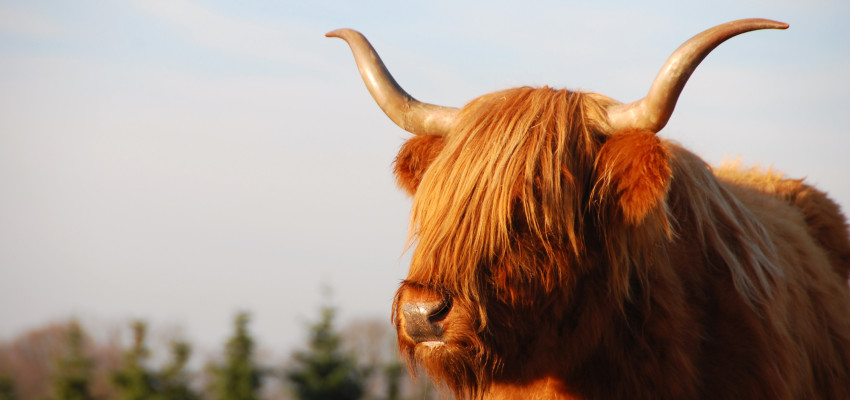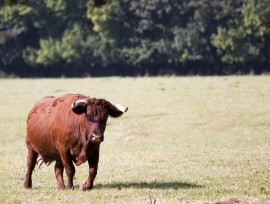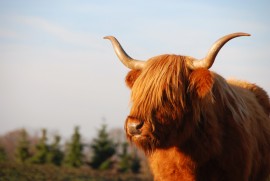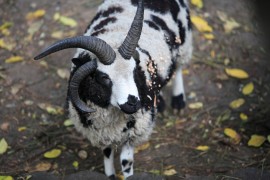By Hannah Becker on July 24, 2017
Five Heritage Livestock Breeds to Watch

Sports have their “players to watch,” but those of us in the livestock world are a little more interested in “heritage breeds to watch.”
Heritage breeds are the “breeds of our forefathers” – livestock variations that waned in popularity through the Industrial Age, but have recently experienced a resurgence as hobby farms and direct-sell markets emerge. They offer many variations in both appearance and production than what we may typically associate with modern, more commercialized breeds (think Angus, Simmental and Charolais).
Here are five historic breeds with unique characteristics and rising popularity.
 American Milking Devon
American Milking Devon
Few livestock breeds get more “American” than the American Milking Devon.
Don’t let the name fool you – Milking Devon cattle can do a lot more than just provide high-quality dairy products.
A key player in the colonization of the United States (think: the Plymouth Colony), the Milking Devon quickly rose in popularity due to multi-purpose uses of both dairy and meat production, along with their propensity to work as a draft animal (like oxen). The Milking Devon’s early American presence was widespread from New England to Florida, with Devons a frequent fixture in early American farms.
With only 600 registered living animals within the U.S., the Milking Devon is one of the most endangered livestock breeds in the world. However, their numbers have continued to rise since the 1970s – a period where less than 100 Milking Devons were listed with the breed registry.
To learn more about the American Milking Devon, visit www.milkingdevons.org.
 Highland Cattle
Highland Cattle
Originally from the Scottish Isles, Highland cattle are recognized as the oldest registered cattle breed in the world. You may have heard Highlands described as “fuzzy” or “hairy” cattle, due to their incredibly generous winter coat. While I’m quite biased, most would agree Highlands are quite cute.
But beyond their teddy bear looks and equally gregarious personality, Highlands possess many positive production qualities that make them a heritage breed favorite. Sporting a reputation for hardiness, meat quality, reproductive traits and ability to graze pretty much anything that grows (invasive cedar trees, anyone?), Highlands have regained popularity both in Europe and the United States. Their meat is often considered leaner and lower in cholesterol than other beef, and their milk was historically desired for its high butterfat content.
To learn more about Highland cattle, visit www.highlandcattleusa.org.
 Jacob Sheep
Jacob Sheep
Named after the spotted sheep Jacob took from his father-in-law’s flock in the Book of Genesis (Genesis 30:31-43), Jacob Sheep have gained popularity in the modern world due to their hardiness and distinct features. In 1988, the Jacob Sheep Breeders Association was formed to register and promote Jacob Sheep within the United States, an important development driving the breed’s recent popularity.
Jacob Sheep are known worldwide for their polycerate (multi-horned) characteristics, with some sheep displaying four or six horns, instead of the typical two. Additionally, Jacob Sheep’s fleece is highly desired by hand spinners, due to its medium grade quality with little lanolin grease.
To learn more about Jacob Sheep, visit www.jsba.org.
Mulefoot Hog
Today, the Mulefoot is the rarest of American swine breeds, with suspected ancestral ties to Spanish swine and the Choctaw hog. Mulefoots get their name from their distinctly solid, non-cloven hoof which looks like the hoof of a mule instead of the typical two-toed pig track. Throughout the 1800s, Mulefoots enjoyed great popularity throughout the Midwest and Ozark regions, but lost favor as our culture embraced a less-agrarian lifestyle.
Like many other heritage breeds, the Mulefoots have retained strong foraging instincts and are easy to “finish” on pasture, efficiently producing impressive hams. Unfortunately, the Mulefoots are considered critically rare in the United States, with less than 200 purebred hogs documented with the registry.
To learn more about Mulefoot hogs, visit www.americanmulefoot.com.
Myotonic Goats
Also known as “Wooden Leg” or “Fainting” goats, Myotonic goats have one of the most unique heritage breed characteristics – they appear to pass out when startled due to an inherited gene that disrupts their fight-or-flight response.
There are numerous folklore-based tales of the Myotonic’s origin, but most agree they stemmed from a herd in rural Tennessee. In addition to their unique fight-or-flight response, the Myotonic goat breed offers producers quality meat, and are noted to be excellent mothers, with the ability to give birth twice a year. Their affable personalities make them a great choice for small farms, and due to their “fainting” gene’s recessive nature, Myotonic goats can be an excellent option for crossbreeding with other breeds.
To learn more about Myotonic goats, visit www.myotonicgoatregistry.net.


